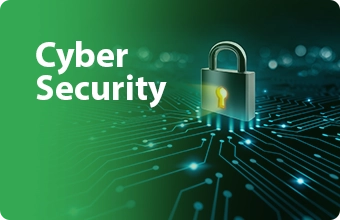Cyber Security
Cyber security, or information security, is the practice of protecting computer systems, networks, and data from theft, damage, or unauthorized access. Learn from the best Cyber Security Training Institute in Kerala and its primary objective is to ensure the confidentiality, integrity, and availability of information in the digital realm. Cyber security involves implementing measures, technologies, and processes to safeguard computers, servers, networks, mobile devices, and data from various cyber threats.

It involves implementing a combination of technologies, processes, and measures to ensure the confidentiality, integrity, and availability of digital information. Furthermore, learn from the Top Ethical Hacking Training Insititute in Kerala and be part of cybersecurity to safeguard against a wide range of cyber threats, including malware, phishing, unauthorized access, and other malicious activities that can compromise the security and functionality of digital systems and data. Moreover, cybersecurity professionals play a crucial role in protecting sensitive information, preventing data breaches, and maintaining the trust and confidence of individuals and organizations in the digital world. In essence, by acquiring the necessary skills and knowledge, you can contribute to a safer and more secure online environment. Ultimately, choosing a career in cybersecurity is not just about protecting data, it’s about safeguarding our digital future.
Key components of cybersecurity include:
- Confidentiality:
Protecting sensitive information from unauthorized access or disclosure. This involves encrypting data, controlling access to systems, and implementing secure communication protocols.
Integrity:
Ensuring the accuracy and trustworthiness of data by preventing unauthorized alterations. This is often achieved through the use of checksums, digital signatures, and access controls.
Availability:
Ensuring that information and systems are accessible when needed. Measures such as redundancy, backups, and disaster recovery plans help mitigate the impact of disruptions or cyber attacks.
Authentication:
Verifying the identity of users, systems, or devices attempting to access a network or resource. This can involve passwords, multi-factor authentication, and biometric methods.
Authorization:
Granting appropriate permissions and access levels to authenticated users. Access controls and role-based access management are common authorization mechanisms.
Network Security:
Protecting the integrity and confidentiality of data as it is transmitted over networks. This includes the use of firewalls, intrusion detection systems, and virtual private networks (VPNs).
Endpoint Security:
Securing individual devices (endpoints) such as computers, smartphones, and tablets. This involves antivirus software, endpoint detection and response (EDR) tools, and device management.
Security Awareness Training:
Educating users about cybersecurity best practices, potential threats, and the importance of following security policies. Human factors are a significant element in cybersecurity.
Incident Response:
Developing plans and procedures to respond effectively to security incidents, breaches, or cyber attacks. This includes identifying, containing, eradicating, recovering from, and analyzing incidents.
- Encryption:
- Protecting data by converting it into a code that is unreadable without the proper decryption key. This is crucial for securing sensitive information both at rest and in transit.
Our Cybersecurity internship offers hands-on experience in real-world projects, allowing you to apply what you’ve learned in a professional environment. Furthermore, during the internship, you’ll work on live projects, gain valuable industry insights, and receive guidance from experienced cybersecurity professionals. In essence, this program is designed to help you build your portfolio and prepare you for a successful career with the best Cyber Security Training Institute in Kerala. Moreover, by immersing yourself in real-world scenarios and challenges, you’ll develop the practical skills and confidence needed to thrive in the dynamic field of cybersecurity. Ultimately, this internship serves as a bridge between your theoretical knowledge and practical application, setting you on a path to becoming a sought-after cybersecurity expert.
Enroll Today!!
Start your path to becoming a skilled cybersecurity professional with our all-inclusive course and internship program. Moreover, whether you’re just starting your career or you’re a professional aiming to improve your skills, the Top Ethical Hacking Training Insititute in Kerala specifically in Thiruvananthapuram, offers the perfect program for your needs. Furthermore, reach out to us today to find out more about our training programs and schedules. In addition, we are here to support you in reaching your career aspirations and becoming a successful cybersecurity expert. Ultimately, by choosing our program, you are taking a proactive step towards securing a rewarding and impactful career in the ever-evolving field of cybersecurity.
You May Like
Our thoughtfully designed internship programs provide a tailored and enriching experience for aspiring professionals.

































